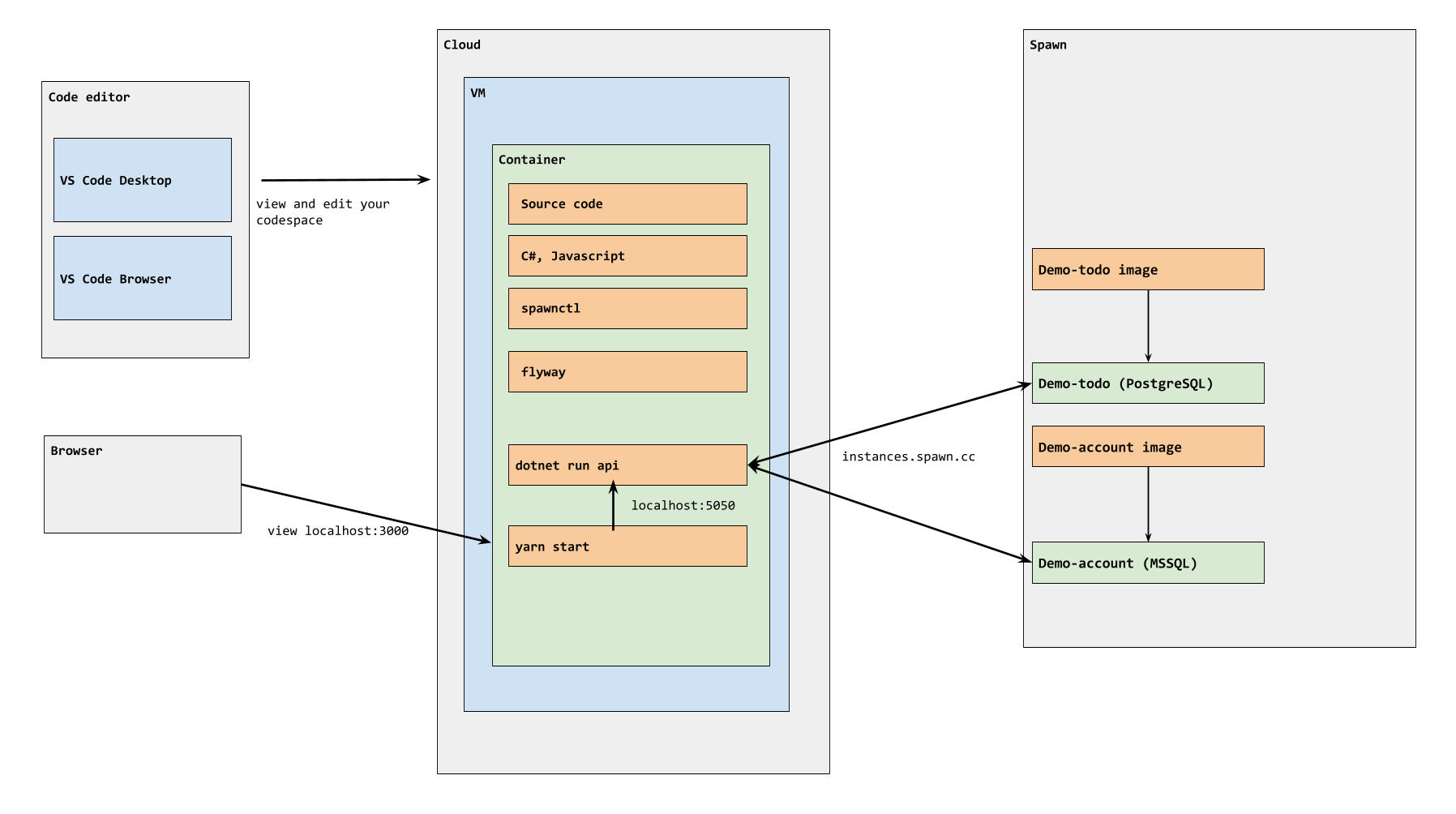Codespaces with databases
With GitHub Codespaces you can set up a cloud-hosted, containerized VS Code environment. You can then connect to a codespace through the browser or through VS Code.
The main question we are trying to answer now is:
Can we have virtualized environments with databases created from backups or scripts, not just empty databases, or fake data sets?
Codespaces lets you:
- Set up your instant dev environment
- Run your app from a codespace container
- Use VS Code or your browser to connect and work against your codespace environment
- Use lifecycle steps to install the dependencies you need to run your app
- Make and commit changes from your codespace
With codespaces you can have databases by running them in docker containers next to your application. This is a good first start but you won't be able bring any volume of data, and this reduces the amount of realistic testing you can do.
Let's now explore how we could use Codespaces with databases and data.
Spawn is a cloud-hosted service that quickly provides databases for dev and test. You can spin up full database instances in seconds with GBs of data and it also allows you to do operations such as reset with no extra time waiting for restores to finish. Spawn can fit nicely with a codespaces setup, in a similar way to the dev containers set up we've discussed in the past.
The code for this article is available here: https://github.com/red-gate/spawn-demo, you will need to have a spawn account as well.
Architecture#
Our demo app is a React frontend application, that connects to a dotnet API. The API uses 2 different databases, a SQL Server database for the information about the user accounts and second PostgreSQL database for holding the information about the todo tasks. And here is the diagram of how things will fit in with codespaces:

Setup your codespace#
Our .devcontainer/devcontainer.json will look like this to start:
The main components to pick up here are:
- a reference to our own
.devcontainer/Dockerfile - 2 ports opens, one for our frontend and one for the API
- a secret token for connecting with
spawn - 2 commands
codespaces-start.shandcodespaces-build.shto prepare our environment
Installing dependencies#
As shown in the diagram, through .devcontainer/Dockerfile , we'll install flyway and spawnctl to manage our database migrations as well as creating databases on the fly for running our app.
We will also set up databases and start them up and update API appsettings:
Setting up secrets#
Follow the Github docs on: Managing encrypted secrets for your codespaces and set up your secrets, in our case we need to set up a Spawn token named SPAWNCTL_ACCESS_TOKEN this will then be available as an environment variable in your codespace environment.

Troubleshooting codespaces#
When starting your codespace you can see the logs by running the View Creation Log command

Which will show you all logs and commands defined under .devcontainer/devcontainer.json
Your codespace is ready#
Once your Codespace is running, all dependencies and code are ready to be used.
spawnctl is already installed and hooked up with the SPAWNCTL_ACCESS_TOKEN so you don't even need to auth!
Notice our 2 databases (PostgreSQL and MSSQL) needed to run the demo-todo app are there. Also, if we check our API appsettings, it has been populated with the necessary connection strings for connecting to these 2 databases.
Under api/Spawn.Demo.WebApi/appsettings.Development.Database.json
You'll see
You'll notice 2 ports are open and ready but no processes are running yet.

Just hit F5 - Running the spawn-demo#
Once inside your codespace we can now hit F5 to run. This will prepare the databases (in this case as databases already exist only migrations need to be run). In this scenario migrations are up to date so none will be applied.
After this the backend and frontend will start up and you should see 2 processes running on each of our ports

And if we browse to our frontend, our app is there, hitting the API and the different databases.

Testing Spawn superpowers#
I created a new todo item from codespaces which will be present in the database as well. We can now test our reset feature of Spawn, to get back to the defaul data that comes with the image.

After performing our reset operation, notice our item is now gone and we are back to the default state of the database.
Conclusion#
Codespaces gives you live environments that you can customize depending on your application needs. And Spawn bridges the gap and brings databases along with it. It brings dedicated, isolated database instances with the data you define. With this setup, you can add data, modify the database schema without impacting your team and your codespace environment. Have a look at our Github repo https://github.com/red-gate/spawn-demo to see how we set up our project with Codespaces and Spawn. You can start using Spawn for free today, and request early access to Codespaces to give it a try.